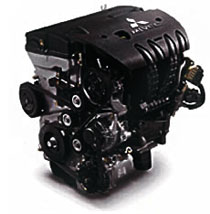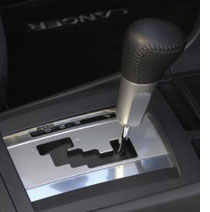
Since the new 2007 Mitsubishi Lancer is coming soon, I decided to dig up some details on the new GEMA engine under the hood. The previous Lancer that is on sale on our market now uses the all-familiar 1.6 liter 4G18 engine, similar to the one that we used to find under the hood of our Proton Waja, with one of the few minor difference is that the Waja uses a 4-speed auto while the Lancer uses a CVT.
The new 2007 Lancer has it’s engine upped to 2.0 liter, putting it head to head with the Civic 2.0. The new GEMA engine is a joint venture project between DaimlerChrysler, Hyundai and Mitsubishi. Hyundai has yet to use the GEMA engine in any of it’s cars, while DaimlerChrysler’s now-sold-off Chrysler used it as it’s flagship 2.0-2.4 liter.
The GEMA engine is called the 4B1x series in Mitsubishi terms, and the 2.0 liter model that we will see in the 2008 Lancer is the 4B11, with the Lancer Evolution getting the 4B11T. It is probably the first time a non-Sirius engine has been used in a Lancer Evolution. All Evolutions, from the Evo I to the Evo IX used some variant of the Sirius 4G63T, with the latest in the Evo IX getting MIVEC variable valve timing.
 The 4B11 is a 4-cylinder DOHC engine with MIVEC variable valve timing on both intake and exhaust valves, making it somewhat equivalent to Toyota’s Dual VVT-i. In it’s US market application, it makes 152 horsepower at 6,000rpm (143 horsepower in California because of higher emission regulations) and 198Nm of torque at 4,250rpm, with 176Nm available from 2,500rpm. The 4B11 uses a new aluminium cylinder block as well as an aluminium cylinder head. A timing chain is used instead of a timing belt.
The 4B11 is a 4-cylinder DOHC engine with MIVEC variable valve timing on both intake and exhaust valves, making it somewhat equivalent to Toyota’s Dual VVT-i. In it’s US market application, it makes 152 horsepower at 6,000rpm (143 horsepower in California because of higher emission regulations) and 198Nm of torque at 4,250rpm, with 176Nm available from 2,500rpm. The 4B11 uses a new aluminium cylinder block as well as an aluminium cylinder head. A timing chain is used instead of a timing belt.
While most engines are usually either bore-biased (rev-happy) or stroke-biased (better torque), the new 4B11 is a “square” engine - it has a bore and stroke that both measure 86mm, giving a good balance of rev-happiness and good torque. It uses as compression ratio of 10.0:1, but can still use RON92 (87 AKI) fuel.
The MIVEC system uses valve overlap to reduce pumping losses under normal conditions, but under high engine speed conditions where maximum power is needed, intake valve closing time is retarded to allow for larger air volume. In a similar high load condition but at low engine speeds, intake valve closing is advanced instead, ensuring sufficient air volume, but exhaust valve opening is retarded to provide a higher expansion ratio and improved efficiency.
To ensure stable idling, valve overlap is eliminated during idle conditions. As previously mentioned, this version of MIVEC can adjust both intake and exhaust valves independently for maximum flexibility in valve control.
Mitsubishi has employed a 4-point inertial axis system with cylindrical hydraulic engine mounts on the left and right sides to help reduce engine vibration, ensuring smooth and quiet operation. On the right side mount where the engine is, a lightweight, high-rigidity squeeze-cast aluminium bracket helps reduce engine noise under acceleration. On the left side where the transmission is, a similar lightweight, high-rigidity plate bracket made of steel helps reduce gear noise. For the front and rear engine mounts, a custom-tuned insulator helps control both idle vibration and acceleration shock.
The engine can be mated to either a 5-speed manual gearbox or a CVT transmission with 6 virtual gears that are selectable using paddle shifts on the steering wheel. Mitsubishi picked 6 gears (in reality because they are unlimited to pick from, you could have 50 CVT virtual gears if you wanted) because it offered the best balance of ease of use, sporty driving, and flexible performance.
The 5-speed manual is an improvement over the old 5-speed transmission - the third and fourth gears now use double-cone synchronisers for smoother shifting and a new honing process was used to reduce noise. The gear ratios have also been adjusted to suit the torque curve of the new engine.
 The CVT transmission’s ratio range is from 2.349 to 0.394, with infinite variations in between, which gives wider ratios than the previous 4-speed auto that had a ratio spread of 2.842 to 0.712. A much higher achievable overdrive ensures good fuel economy and lower engine speed for highway cruising. The INVECS-III software in the CVT customises shift patterns on the fly to match the acceleration and brake patterns of the driver. If you select the L mode, the INVECS-III software shifts to allow for more engine braking if the car has to go down slopes.
The CVT transmission’s ratio range is from 2.349 to 0.394, with infinite variations in between, which gives wider ratios than the previous 4-speed auto that had a ratio spread of 2.842 to 0.712. A much higher achievable overdrive ensures good fuel economy and lower engine speed for highway cruising. The INVECS-III software in the CVT customises shift patterns on the fly to match the acceleration and brake patterns of the driver. If you select the L mode, the INVECS-III software shifts to allow for more engine braking if the car has to go down slopes.
Something alot of people miss when switching from conventional fixed ratio gearing to CVTs is the lurching feel when you floor the pedal from a stand still. The way a CVT-equipped car starts may be interpreted as sluggish by our minds - this is known as the rubber band effect. INVECS-III can simulate this lurching that the driver expects.
Anyway, this engine looks like a very modern engine with a gearbox combination that promises to be great for both city and highway driving. You’ve got ample amounts of torque from a low 2,500rpm for a comfortable city drive, plus a CVT to keep the revs at the sweet spot. You’ve got a good low maximum overdrive ratio of 0.394 for good highway fuel economy and a relaxed low engine speed cruise. Finally, for whenever you feel like driving spiritedly, there are the paddle shifters.
On paper, the Lancer’s drivetrain sounds good. An invite for the launch, Mitsubishi Malaysia? ![]()
UPDATE: Look at two videos after the jump explaining some technical details on the 4B11 as well as it’s matching INVECS-III CVT gearbox, thanks to reader Rikeys.
No comments:
Post a Comment